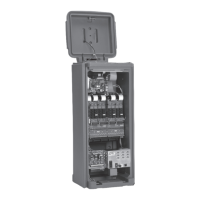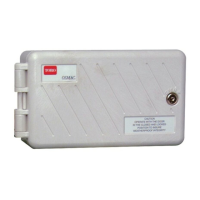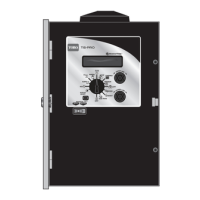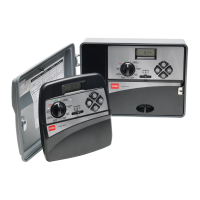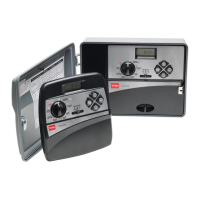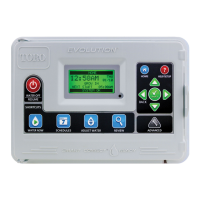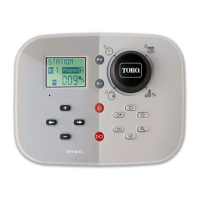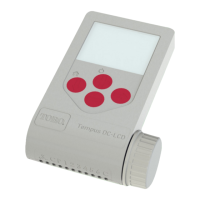Do you have a question about the Toro Sentinel and is the answer not in the manual?
| Type | Modular |
|---|---|
| Mounting | Wall |
| Enclosure | NEMA 3R |
| Communication | Ethernet |
| Water Management | Master Valve |
| Compatibility | Toro |
| Stations | Up to 48 |
| Power Supply | Included |
Overview of the Sentinel Control Module, covering its LCD screen, knob, and buttons.
Details the Sentinel Controller's six-line LCD screen and its displayed information.
Explains the purpose of the five LEDs on the Sentinel Control Module for status indication.
Describes the function of the Control Knob and navigation arrows used for operation.
Details the function of each button on the Sentinel Controller interface.
Lists and describes the purpose of the top serial, data retrieval, network, and UHF radio ports.
Lists and describes the purpose of the bottom station output, AC adapter, USB, and fuse ports.
Outlines the settings and functions for manual station operation.
Details settings for scheduling individual station watering times by program.
Covers showing and clearing various types of alarms on the controller.
Describes settings for plant factor, days off, maximum/expected flows, and station type.
Explains options for shutting down stations, manual, and automatic programs.
Covers settings like time, day, ET, language, and flow processing for the satellite.
Explains icons used in the manual to portray certain functions.
Introduces basic programming for satellite settings like Time & Day.
Step-by-step guide to setting the system's time and date.
Details how to set Default and Maximum ET values for evapotranspiration.
Explains how to specify the controller's language setting.
Describes turning Flow Processing ON/OFF to monitor water flow.
Explains how to set K and Offset values for flow meter 2.
Explains how to set K and Offset values for flow meter 1.
Details configuring the master valve/pump start output as normally open or closed.
How to inform the controller about the number of stations it has.
Assigning a unique three-digit code (address) to each controller.
Setting the hour at which the controller advances to the next day.
Initiates automatic watering cycles for each program.
Enables or disables ET-based program adjustments.
Clears all programming information from a selected schedule.
Selects whether a schedule is based on a 6-week or 365-day calendar.
Configures watering days for each of the sixteen independent schedules.
Resets all slot/station times within a selected program to zero.
Disables programs for a specified number of days due to rain.
Assigns a watering day schedule to a program for it to run.
Defines the start and end times for automatic watering within a 24-hour period.
Repeats a program cycle continuously for the defined Water Window duration.
Places a delay period between program repeats.
Enables watering cycles to be repeated a specified number of times.
Adjusts station run times by a percentage of the programmed time.
Organizes and controls satellite station outputs within irrigation programs.
Covers manual operation of stations and starting/stopping programs.
Describes how to manually operate up to six stations at one time.
Details how to start and stop specific programs by number.
Shuts down all currently active stations immediately.
Turns off all manually operated stations without individual selection.
Turns off any automatic or manually started programs that are running.
Displays current alarms and the last time/date an alarm occurred.
Tests UHF radio communication with another satellite.
Strobe test for all controller outputs based on station type.
Tests outputs by strobing through the first 48 outputs one at a time.
Prompts operator to press keys and operate the Control Knob to check functionality.
Clears display and turns on pixels line by line to check for defects.
Checks the hardware function of Port 1/Front using a loop back adapter.
Checks the hardware function of Port 0/Back using a loop back adapter.
Clears all satellite alarms on all stations.
Clears all communication alarms on all stations.
Clears all electrical alarms on all stations.
Clears all flow alarms on all stations.
Displays incoming moisture data from an optional Turf Guard receiver.
Assigns a percentage factor to a zone based on plant material.
Disables individual stations for a specified number of days.
Sets the maximum or minimum flow values in GPM for each station.
Enters the expected flow values (GPM) for individual stations.
Maps stations to, or associates them with, hardware other than the controller output board.
Selects the station type per station from a list of available types.
Sets the amount of water a zone applies in inches per hour.
Sets the unit code of a satellite for UHF radio tests.
Enables a port for specific functions like CTM, wireless, or 2-wire systems.
Enables a port for specific functions like CTM, wireless, or 2-wire systems.
Specifies TCP/IP settings for the Sentinel satellite, including DHCP.
Programs Baseline decoder port addresses for each decoder.
Programs AC decoder port addresses for station, flow, and moisture decoders.
Confirms the serial port is set to BL/TORO AC 2-Wire.
Confirms the station type is set to Toro AC 2-Wire for decoder stations.
Maps stations to their particular decoder addresses.
Reprograms decoder addresses if they are sequential or unknown.
Instructions for updating firmware and language programming.
Explains reasons why the alarm indicator might remain blinking after clearing alarms.
Explains the removal of 2Wire/Irritrol Mode and its implications.
Identifies causes and solutions for the controller showing no display.
Addresses issues where the controller fails to irrigate as scheduled.
Troubleshooting steps for when water fails to turn ON.
Troubleshooting steps for when water fails to turn OFF.
Troubleshooting for when the rain sensor does not shut down the system.
